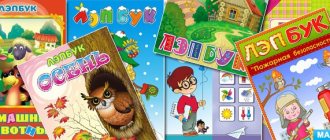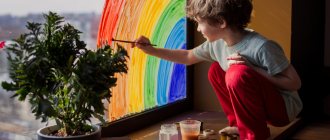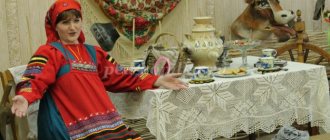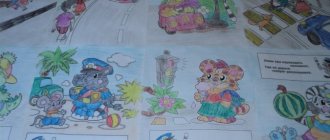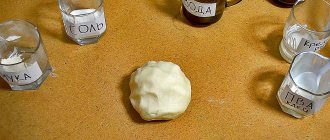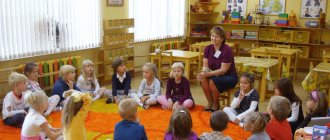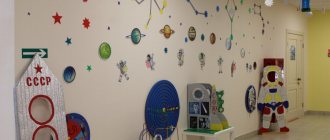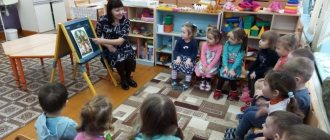8 minutes
Published:October 26, 2016
| (0) |
A healthy lifestyle has already become a full-fledged family culture. Giving up bad habits and focusing on sports have become fashionable. Therefore, more and more people are becoming interested in healthy lifestyles and attracting not only adults, but also children into their ranks. This trend has a positive effect on a person’s overall health, promotes strong immunity, good health, a beautiful figure and a positive attitude. By teaching children a healthy lifestyle, you help them live a long and happy life, full of bright and positive moments. This is the best care for loved ones, which will definitely bear fruit in the near future. A healthy lifestyle is no less important for children than for adults. After all, this is a fundamental principle of child development in the areas of moral and physical culture. The earlier you start the habit of eating right and exercising, the more benefits it will bring in the future.
Components of a healthy lifestyle
The main components of a children's healthy lifestyle are:
- playing sports and introducing physical activity as a regular habit;
- regular walks in the fresh air;
- proper nutrition.
maintaining a healthy lifestyle for the whole family;
All physical activity must be appropriate for the child’s age and take into account the characteristics of his health. Regular exercise under the guidance of experienced trainers is the best option for maintaining a healthy lifestyle for children. The European Gymnastics Center offers you classes in a comfortable environment and on a convenient schedule. A lot of positive emotions, playful training and socialization of each child is the minimum set of services that we offer to each client.
System of working with children 3–4 years old to develop a healthy lifestyle
Svetlana Medvedeva
System of working with children 3–4 years old to develop a healthy lifestyle
Presentation “ System of working with children 3-4 years old
formation of healthy lifestyle»
Slide No. 2: Statement by V. A. Sukhomlinsky
The first ideas about health and a healthy lifestyle are formed already in preschool age. This period is fundamental in the formation of a person’s personality. It is during this period that there is intensive development of organs and the formation of functional systems of the body , the basic personality traits, attitude towards oneself and others are laid.
“Taking care of health is the most important job of a teacher. Their spiritual life, worldview, mental development, strength of knowledge, and self-confidence depend on the cheerfulness and vigor of children.”
V. A. Sukhomlinsky
Slide No. 3: Goal and Objectives
The purpose of the work :
Formation in children of ideas about a healthy lifestyle, means of promoting health and the rules of caring for it.
Tasks:
• — Develop healthy lifestyle skills, the need to engage in physical education;
• — Provide preschoolers with the necessary technologies to maintain and improve health;
• — Enrich knowledge about a healthy lifestyle through various activities.
Slide No. 4: The main components of a healthy lifestyle
The daily routine in kindergarten is designed in such a way that there is an alternation of independent children's activities, collective and individual games.
Class time is organized so that first classes related to mental activity are carried out, and then creative activities alternate with musical and physical activity.
The intervals between meals, bedtime and daily walks remain unchanged. During the warm period of the year, the daily duration of children’s stay in the fresh air increases; if conditions exist, classes are transferred to walks.
Slide 5: Prevention of emotional stress
Imitation games are played with the kids: “The cat washes itself”
,
“My smart assistants” (games help you figure out what your nose, eyes, ears, etc. are for)
.
To create emotional comfort, we use possible methods:
- creativity, in which the child enjoys the process of creating something new and learns to express his feelings and emotions;
-communication with peers;
- theatrical games;
-musical accompaniment, which increases emotional tone, contributes to the formation of a positive , optimistic attitude towards life, which is very important for the development of a strong nervous system .
Music can also be a way to relieve anxiety and fatigue.
Slide 6,7,8: Development of physical exercises
Health and movement are two interrelated components in a child’s life. In our group, we create a motor mode that is observed in the process of working with children .
Means of motor orientation:
• Physical exercise;
• Physical education classes;
• Physical education minutes;
• Morning exercises;
• Gymnastics after a nap;
• Finger gymnastics, visual, breathing, corrective;
• Outdoor and sports games help improve the functioning of all organs and the body as a whole.
In the process of physical education, the child acquires knowledge, skills, abilities; Children develop strong-willed qualities and emotional sphere, besides, movement activates appetite, improves metabolism and digestive processes.
In our group we try to vaccinate kgn.
Slide 9: Instilling cultural and hygienic skills
Hygienic measures should become common and subjectively necessary for a preschooler - this can be achieved by regularity and perhaps earlier introduction.
From the first days we teach the child cultural and hygienic skills: his own comb, his own bed, his own handkerchief, his own towel, his own locker for clothes.
Slide 10: We teach the child to do hygienic work
To achieve the effectiveness of the formation of CGN, didactic games, exercise games, conversations, reading fiction, looking at illustrations, paintings, observations, showing dramatizations, storytelling, memorization, and role-playing games are used.
We organize training not only in the classroom, but also in everyday life, when situations arise that prompt children to make a decision on this problem.
The next component of a healthy lifestyle is proper nutrition.
Slide 11: Proper nutrition
In classes and conversations, children learn about tasty and healthy food, healthy and unhealthy foods, vitamins contained in certain foods, table manners, and food culture.
It is important that proper nutrition is available in the families of our students. We recommend that parents follow the same meal schedule on weekends and holidays as in kindergarten.
Slide 12: Gymnastics after a nap is the next component.
children and I do invigorating gymnastics every day after nap, which lasts 5-8 minutes. Its goal is to improve the mood and muscle tone of children, relieve lethargy and drowsiness, and help children quickly enter an active state. During the event we use musical accompaniment that evokes pleasant positive emotions. It is very important to teach a child to perform various movements correctly and efficiently, so that he can then use them in everyday life.
Hardening procedures also play an important role.
Slide 13: Health tracks
Hardening helps solve a whole range of health problems: the activity of the body, its systems and organs , resistance, endurance and performance .
Our group carries out an extensive range of hardening activities:
• maintaining the temperature regime during the day,
• proper organization of the walk and its duration,
• observance of seasonal clothing during walks, taking into account the individual health status of children;
• lightweight clothing for children in the group,
• breathing exercises ;
• washing, washing hands before eating;
• ventilation of premises;
Slide 14: Walk
The most important means of hardening is a daily walk with the inclusion of different types of games: active, sedentary, didactic, speech, etc.
Slide 15: Breathing exercises
Breathing exercises play an important role in the process of healing and hardening of preschool children.
It is a good prevention of respiratory diseases, develops the child’s imperfect respiratory system , and strengthens the body’s defenses.
We perform breathing exercises systematically , once or twice a day for several minutes, using different physical activity.
Slide 16: Gymnastics for the eyes
To relieve eye strain, we perform visual exercises 2-3 times a day for 3-5 minutes. For gymnastics we use different objects, carry them out according to verbal instructions using poems and nursery rhymes. When planning, we take into account the principle of complication, practicing simple eye movements: right-left, up-down, circular movements, squinting, blinking, protruding the eyes. Then we use them during a more complex poetic text in various combinations.
Slide 17: Prevention of flat feet
In order to strengthen the muscular-ligamentous apparatus of the ankle joint and foot, we use various types of walking: on sand, on grass, on ribbed paths, on massage mats, on an inclined plane. We massage the feet: walking on the heels, toes, the outer edge of the feet, bending the toes etc. during morning exercises and physical education classes.
Slide No. 18,19: Interaction with parents
Our main allies in our work to develop healthy lifestyle habits in children are parents.
In our work with families we use the following forms :
• — information stands;
• — questioning
• — health library;
• — health information corners;
• — consultations, conversations with parents on health issues;
• parent meetings;
Thus, a variety of forms of cooperation with families on the issue of a healthy lifestyle allows us to instill in children a sense of responsibility for their health. We are convinced that not a single, even the best physical education and health program can give full results if it is not decided together with the family. Joint activities to improve the child’s health with parents are one of the main aspects of parenting.
Slide 20: Thank you for your attention!
In conclusion, it should be noted that this area of work will be continued .
Be healthy!
Family healthy lifestyle
Before telling or explaining something to your child, show it by personal example. This will be the best motivation for him, because a son or daughter always strives to be as similar as possible to their parents. Therefore, when talking about a healthy lifestyle, make sure that you yourself do not violate its basic principles. It is quite easy to become a worthy example for your child.
Together everywhere.
Take regular walks. But don't limit them to shopping. Go to the park, go out into nature, visit children's outdoor playgrounds.
Eat the right foods.
Teach your children to eat healthy. Avoid visiting cafes that serve fast food. Add more vegetables and fruits to your diet, and drink more clean water together. Avoid carbonated drinks and packaged juices if possible.
Remember mobility.
Don't forget about ball games, visiting the pool, skiing and skating. A morning run is a great way to recharge your energy for the day ahead, not only for you, but also for your children.
One hobby.
Involve your child in your hobbies. This will not only help in his upbringing and general development, but will also unite the family in an interesting hobby.
Rejection of bad habits.
Remember that a child always looks up to his parents and tries to imitate them in everything. To instill in him a correct perception of the world, give up smoking, alcohol, high-calorie snacks and regular evenings in front of the TV.
Fundamentals and methods of creating a healthy lifestyle
A healthy lifestyle has 7 main “pillars”: physical activity, a balanced diet, the absence of bad habits, hygienic care, adequate sleep and rest, wellness treatments and an emotional state.
If you take care of all these aspects, your quality of life and well-being will improve significantly. Maintaining proper nutrition
The health of internal organs, appearance, well-being and immunity directly depend on what we eat. A healthy lifestyle involves eliminating, or at least reducing, flavorings, flavor enhancers, fatty foods, dyes and preservatives.
Here are the basic rules:
- You should neither starve nor overeat - both have a negative impact on your well-being. You should not feel hungry and, conversely, overeat. Try to ensure that your daily calorie intake is 1700-1900 kcal (the norm for women leading a sedentary lifestyle; for men the daily calorie intake is approximately 300-400 kcal higher).
- Drink clean water. It is advisable to drink 1.5 to 2 liters of water per day (not tea, coffee, juice, etc.)
- Reduce the amount of sweets in your diet. If you want something sweet, give preference to fresh vegetables and dried fruits. You can also consume dark chocolate in moderation.
- Eat small meals at least 4-5 times a day. At the end of the meal, you should still feel slightly hungry.
- The daily menu should contain meat or fish, vegetables and fruits, cereals, and dairy products. Eat a varied diet.
- It is advisable to have dinner at least 2 hours before bedtime. It is not advisable to eat immediately before bed.
- Eliminate fast food, fatty and smoked foods from your diet.
- Give preference to boiling, stewing or baking foods.
If you haven't watched your diet before, it may be difficult for you to suddenly change your diet.
Try to start small - remove fatty sauces and foods that contain them from your diet, avoid flavor enhancers and chemical additives in food, give up fast food products, convenience foods, confectionery, increase the share of fruits and vegetables in the menu. Completing each of these points will be a step towards a healthy diet. Physical activity
Lack of physical activity leads to a decrease in metabolic rate, the development of diseases of the musculoskeletal system, cardiovascular and neurological pathologies.
If your job does not involve movement, try to increase your activity yourself. It is considered normal to spend at least 1 hour a day in motion (this is about 8000-10000 steps). Scientists have proven that every minute of activity affects the body's condition in the long term - this means that even climbing the stairs, rather than taking the elevator, already brings you closer to health.
You can increase your daily activity by making it a habit to start and end your day with a light workout.
If you go to work by public transport, get off 1-2 stops earlier and walk this way. It is very useful to take breaks if you have a sedentary job. On weekends, do some fitness, go for a walk or go to the pool. These measures are quite enough to maintain health and well-being. Hygienic care
Personal hygiene is one of the components of a healthy lifestyle. First of all, this concerns the oral cavity. You need to brush your teeth at least twice a day, and pay attention to the entire oral cavity. In addition to the standard set consisting of a toothbrush and toothpaste, get a irrigator, dental floss and mouth rinse. Failure to comply with these rules is fraught not only with the development of caries, but also with the threat of periodontitis and gastrointestinal diseases.
It is also important to keep the house in order: regularly carry out wet cleaning, prevent dust accumulation, and ventilate the rooms daily.
Maintaining a daily routine
Scientists have concluded that sleep duration and regularity are important for health and well-being.
Every person should sleep at least 7 hours a day. At the same time, it is advisable to fall asleep and wake up at the same time. Of course, sometimes exceptions can be made, for example on weekends. Emotional mood
Nervous tension, constant breakdowns, stress - all this negatively affects mood, well-being and health in general. Experts recommend adhering to the following tips:
- Don't worry about what you can't change. If you cannot cope with anxiety, seek help from a psychologist.
- Think positively, find positive aspects in any situation.
- Don’t hold a grudge, let go of all grudges, don’t envy and don’t do harm to people.
- Try to avoid stressful situations.
Proper nutrition for a child
Not all children eat what their parents offer them. Many adults complain that the child does not accept vegetables or lean meat, but prefers to eat exclusively one product that is not beneficial for the growing body. Even if the consequences of poor nutrition are not particularly noticeable now, in the future this can lead to the formation of an eating disorder. Therefore, it is extremely important to teach your child to eat the right foods in the right quantities. There are several basic principles that are called “smart plate”.
For the mind.
About a quarter of a child's diet should consist of foods rich in starch (cereals, potatoes, whole grain bread, corn and peas). These are the best sources of easily digestible carbohydrates, without which an actively developing body will not be able to function properly. Add fresh berries and fruits here, and it will be easier for the child to cope with complex mental problems.
For quality digestion.
Half of the diet is vegetables (cabbage, tomatoes, legumes, carrots, spinach, broccoli, cucumbers, etc.). They also contain a large amount of vitamins and minerals necessary for the growth of the child.
For strong and resilient muscles.
The remaining portion is animal protein, which is best obtained from lean meats (turkey, lean beef, chicken, and fish). Without these products, the child may experience developmental delays.
For fast metabolism.
All children need to drink enough fluids. It is better if it is clean drinking water. As a last resort, homemade juices, compotes and fruit drinks without large amounts of sugar are allowed.
When the problem exists at the genetic level.
If a child is predisposed to obesity, special attention should be paid to his diet. Excess weight can cause serious health problems in the future.
Prohibited foods for children's diets.
Many children love sweets and unhealthy but very tasty foods such as hamburgers and fries at fast food restaurants. But this is precisely where they should be limited. Be prepared to protest and refuse to eat healthy food. Try to redirect your child's attention when he asks for something harmful. Stay calm and don't get emotional. Prove the correctness of your action by personal example. For older children, the principle of encouragement is suitable. Each week spent without harmful products can end with something interesting for the child: a trip to the cinema or to the skating rink.
Game - quiz “I choose a healthy lifestyle”
Game summary - quizzes about a healthy lifestyle
“I choose a healthy lifestyle”
for students in grades 1-4
Prepared by:
Social teacher
Municipal educational institution "Shakhterskaya Secondary School in the village of Maloorlovka"
Rakus O.V.
Target:
Forming an idea and understanding of what a healthy lifestyle is and how to maintain your health.
Tasks:
— Cultivate a caring attitude towards your health.
— To develop in children a sustainable interest in physical education and sports.
- Promotion of healthy lifestyles.
Planned results:
— to form in students an idea of the need to strengthen and maintain their health, the ability to resist bad habits, and lead a healthy lifestyle.
Materials:
diplomas for awarding winners, posters about health, emblems for teams, envelopes with letters for the competition.
Form of conduct
: Quiz game.
Event participants:
1-4 grades.
Quiz progress
I. Organizational moment
The long-awaited bell has been given - the lesson begins!
There are ideas and tasks, Games, jokes, everything for you! We wish everyone good luck - Good luck to work! II. The main part of Sots.ped.:
HEALTH is an invaluable gift that nature gives to man. Without it it is very difficult to make life interesting and happy. But how often do people waste this gift, forgetting that losing health is easy, but getting it back is very, very difficult, and sometimes even impossible.
— What do you think is the topic of our lesson today, what will we learn about and consolidate our knowledge?
(Children's answers)
— That’s right, today we’ll talk about healthy lifestyle and learn a lot of interesting facts about our health.
— The word “health” is one of the most common words that a person uses in his speech. We even associate greetings during meetings and partings with this word: “hello”, “be healthy” and others. What is health? The simplest answer is that health is the absence of disease. Life expectancy is influenced by many factors, but the most important thing is a healthy lifestyle!
—Have you ever wondered what the meaning of these words is? (Children's answers)
Children prepared in advance read T. Latysheva’s poem “I love the seven rules of a healthy lifestyle.”
1st student:
I love the seven rules of a healthy lifestyle After all, you can’t live without them!
For health and order Start your day with exercise. You don't eat meat in dough, your waist will be in place. 2nd student:
I slept for a long, long, long time - This is a signal of illness.
Temper yourself, exercise, and don’t give in to the blues. I love sports and fruits, thus protecting my health. I follow all the regimes, and I don’t know any diseases. 3rd student:
I won’t eat much at night, I’m taking care of my figure.
I don't smoke or drink, I want to be healthy. I bathe, shower myself: It is clear to everyone that I am strengthening myself, I have thrown away a lot of troubles - I have strengthened my immunity. 4th student:
Eat apples and pears, your skin will be better. Eat another lemon, it will help you absorb calcium. I am actively resting and strengthening my health, I don’t complain about anything, and I advise you to do the same.
5th student:
I also play chess: I develop my intellect.
I’ll get on the “path”: I’ll lose a little more weight, you eat five times a day, there won’t be heaviness in your stomach, drink milk with honey, and you’ll fall asleep easily. 6th student:
Relaxing does not mean sleeping. Go to the dacha to dig. When you return home, take a shower and sing a song: That’s why I’m so good, Because I love the seven rules of a healthy lifestyle.
Social ped.:
Well done!
Now let's start our quiz. (Children are divided into 5 teams of 4 people in each team.)
Quiz competitions
1. “Motto”
(up to 3 points)
Come up with a motto for the teams, taking into account the topic of this quiz.
2. “Give an answer” (2 points for a correct answer. Questions are asked to each team in turn; if one of the teams cannot give an answer, the right to answer goes to the next team).
1. What should you do to avoid getting sick?
(Proper nutrition, sleep, active activity and active rest, absence of bad habits, observance of personal hygiene rules, physical education, hardening)
.
2. At what age is it useful to engage in physical education? (In any)
3. What time of year is best to start hardening?
(In summer)
.
4. Who are “walruses”? (People swimming in an ice hole in winter)
.
5. Who are yogis? (People doing gymnastics, meditation)
.
6. What medicinal plants do you know? (Valerian root, chamomile, sage, St. John's wort, mint, etc.)
7. What fruits, vegetables and plants are used to lower fever and treat colds?
(Raspberry, lemon, garlic, linden)
.
8. Leaves of which plant are used for bruises and bleeding? (Burdock, plantain)
.
9. Is the juice of this plant used instead of iodine? (Clandestine)
.
10. Why can’t you drink water from a river or puddle? (Dirty water contains various microbes that carry dangerous diseases)
.
11. Why can’t you pet stray and other people’s cats and dogs? (You can catch ticks, lichen)
.
12. Is it possible to eat unwashed vegetables and fruits? Why? (No, because there are many different microbes on them)
.
13. Name winter sports? 14. What are the summer sports? 3. “Guess” (2 points per answer)
You need to guess
riddles on the topic of healthy lifestyle
1. You will gnaw steel pipes, If you often brush... (teeth)
2. I take dumbbells boldly - I train my muscles...
(body)
3. I made friends with physical education - And now I’m proud of...
(my figure)
4. Juice, tablets are the healthiest of all, It will save you from all...
(diseases)
!
5. Since childhood, everyone has been told: Nicotine is deadly... (poison)
6. Even though it stings and burns the wound, it heals perfectly - red...
(iodine)
7. For Alyonka’s scratches, there is a full bottle...
(green stuff)
8. They declared a fight against the bacilli: Mine clean your hands with ...
(soap)
9. There are vegetables and fruits.
Children need to eat a lot. There are also 10 tablets. They taste like candy. Take them for health during cold times. For Sashulya and Polina What is useful? - ... (Vitamins)
11. Bone back, Bristles on the belly, Jumped along the picket fence, Washed up all the dirt.
(Toothbrush)
12. I have no time to be sick, friends, I play football and hockey.
And I am very proud of myself, What gives me health... (Sports)
13. Forget about the computer.
Go outside for a walk. After all, fresh air is healthier... (Breathe)
14.
Very bitter - but useful!
Protects against diseases!
And he is no friend to microbes -
Because it is - (Bow)
4. “Physical exercise”
(up to 3 points)
Each team must come up with and demonstrate a sports movement.
(The rest of the teams repeat the movements.) 5. “Blitz survey”
So, now I will ask each team questions, you need to answer Yes - No, for the correct answer you get 1 point.
1. Do you agree that exercise is a source of vigor and health? (yes)
2. Is it true that chewing gum preserves teeth?
(no)
3. Is it true that cacti remove radiation from a computer?
(no)
4. Is it true that smoking kills 10,000 people every year?
(yes)
5. Is it true that bananas lift your spirits?
(yes)
6. Is it true that carrots slow down the aging process of the body?
(yes)
7. Is it true that there are harmless drugs?
(no)
8. Is it easy to quit smoking?
(no)
9. Is it true that milk is healthier than yogurt?
(no)
10. Do adults break their legs more often than children?
(yes)
11. Is it true that children need to drink milk every day?
(yes)
12. Is it true that in the summer you can stock up on vitamins for the whole year?
(no)
13. Is it true that lack of sun causes depression?
(yes)
14. Is it true that children under 15 years old cannot engage in weightlifting?
(yes)
15. Is it true that 6 hours of sleep is enough for a child?
(no)
Well done, guys!
6. “Types of sports” competition for captains (2 points for 1 sport)
Name as many sports as possible that begin with the letters: F, V, P, T, B. The team captain chooses an envelope containing one of the letters .
Sample answers: F: football, fencing, figure skating, freestyle, B: volleyball, cycling, freestyle wrestling, water polo P: paintball, swimming, jumping T: triathlon, tennis, sports dancing, B: basketball, biathlon, bobsleigh, boxing , wrestling IV.
Awarding Summing up, presentation of diplomas.
V. Reflection
– What was the task set today? – Did you manage to solve it? – What do you think the knowledge gained today can be useful for? – Can you use the knowledge you have gained and recommend anything to your friends and family? – What did you like most? What didn't you like?
— How do you feel when you leave today’s lesson?
Sports lifestyle
For exercise to become a healthy daily habit, it must be introduced at an early age. When a child has the opportunity to direct his energy in the right and safe direction, he feels comfortable not only physically, but also emotionally. Regular workouts contribute to a surge of strength and good mood. Sports also teach overcoming difficulties, determination, discipline and perseverance. This will help the child already at school. It is very important to focus on those activities that children enjoy. Early physical development can begin as early as 1.5 years. Special exercises should be included in classes from 4 years of age. The European Gymnastics Center has everything you need to teach children a healthy lifestyle. Our coaches have extensive experience working with children of different age categories and will be able to find an approach to any young athlete.
Benefits of healthy lifestyle
A healthy lifestyle has a significant impact on immunity.
According to a survey of those who recently changed their lifestyle, after starting a healthy lifestyle, their well-being, mood, and worldview changed noticeably. In addition, striving to live a healthier life leads to the following improvements:
- The frequency of relapses of chronic diseases is reduced;
- When you wake up, there is no fatigue, you feel a surge of strength;
- Increased endurance during sports training is observed;
- The frequency of colds is reduced and their severity is reduced;
- The skin becomes firmer and cleaner.
In addition, research shows that this lifestyle can reduce the likelihood of developing a number of age-related diseases. In addition, this is an excellent example for loved ones, and, first of all, for children.
Physical activity
Parents should remember that the intellectual development of a child is only half of the compulsory activities from an early age. Children need to harness their energy to be able to concentrate on their studies. Don't forget about playing outdoor games together: football, volleyball, etc. Play active sports. Instead of using public transport, take a walk. In winter, you should also not refuse to visit parks and skating rinks. Don't worry that your child may become overtired. A well-organized daily routine combined with proper nutrition will allow him to always be in good shape.
If you do not have enough free time to play sports with your child on your own, trust the professionals. The trainers of the European Gymnastics Center will help him reach his potential in a playful and positive atmosphere and teach him the basics of a healthy lifestyle.
If you have any questions, you can consult with our specialists by calling +7 (495) 477 32 69 or leaving a request for a free trial lesson.
Sign up for a free lesson
All articles
Healthy lifestyle for children
Healthy lifestyle tips for children |
Both adults and children want to be healthy, beautiful, and full of energy. What should you do for this? Just know and follow the rules of a healthy lifestyle.
What is it - Healthy Lifestyle
(HLS)?
We give a definition for adults: “a healthy lifestyle is a person’s way of life aimed at preventing diseases and promoting health; a system of reasonable human behavior that provides a person with physical, mental, social well-being and active longevity.” (from the website of the international public movement “Healthy Planet” https://www.zdorovajaplaneta.ru/zdorovyj-obraz-zhizni-zozh)
Definition for children: a healthy lifestyle is actions aimed at improving health. So, to be healthy, you need not to neglect the rules of personal hygiene and daily routine, eat right and exercise.
Personal hygiene.
Cleanliness is the key to health (Russian folk proverb).
Personal hygiene for children |
The main requirement of hygiene is to keep the body clean. This will save you from the risk of getting diseases associated with the proliferation of bacteria and parasites. To do this, you must follow basic hygiene rules.
1.Be sure to brush your teeth
after waking up in the morning and before going to bed.
2. Wash your hair regularly.
3.Keep combs, elastic bands and hair clips clean.
4.Take a shower or bath
2 times a day.
5. Be sure to wash your hands
upon arrival home, before and after meals, after playing with animals, after using the toilet.
6. Pay attention to the cleanliness of your clothes and shoes.
Daily regime
Sit and lie, wait for illness (Russian folk proverb).
Illustration by K. Rotov for A. Mitta’s poem “The Miracle Bed” |
| Illustration by K. Rotov for A. Mitta’s poem “The Miracle Bed” |
You will say that the daily routine was invented by parents, educators and teachers. Absolutely right! It is these people who care about how children feel, in what mood they start their lessons and activities, and whether there is time during the day for food and entertainment.
So, the daily routine is the correct distribution of time for sleep, work, food and rest.
It happens that we violate the daily routine: we get up late, eat when we want, watch movies or cartoons until late, lie on the couch. But if a person always lives like this, he will become a capricious lazy person, and without proper nutrition and walks in the fresh air, he will also get sick.
So the basis of a proper daily routine and good health is:
- Normal sleep duration ( A student should sleep at least 9-10.5 hours).
- Maintain a consistent bedtime and wake-up time each day.
- Maintaining a meal schedule.
- Maintaining a balance between academic activities at school and at home with active recreation and spending time in the fresh air. ( After returning from school, the child must have lunch and be sure to rest. Rest will be about 1-1.5 hours, without reading books or watching TV.
It is recommended to start doing homework with the least difficult subjects, moving on to more complex ones. Every 30-40 minutes When completing lessons, you should take 15-minute breaks with physical education to music)
.
You can build your daily routine by consulting with your parents. The main thing is to find the strength to comply with this regime!
Proper nutrition.
As you chew, so do you live (Russian folk proverb).
Photographer Samantha Lee creates paintings from ordinary food. Photo from the site https://www.libo.ru. |
| Photographer Samantha Lee creates paintings from ordinary food. |
Photographer Samantha Lee creates paintings from ordinary food. Photo from the site https://www.libo.ru. |
It is clear that adults prepare food for children. It is clear that children need a lot of strength to grow and mature. And they should get everything they need from food rich in microelements, minerals and vitamins. The lack of a balanced, nutritious diet can result in spoiled health for life. Therefore, you need to try to eat everything healthy that your parents offer you. The rules of healthy eating are quite simple and do not require special skills.
Eat vitamin-rich vegetables and fruits
. Don’t give up those vegetables and fruits that you once found tasteless, try them again, maybe you’ll like them. Fresh vegetables and fruits will not only satisfy your hunger, but also replenish the lack of nutrients.
Consume dairy products
(kefir, yogurt, cottage cheese, sour cream, etc.). They contain healthy protein and promote normal digestion.
Eat porridge.
They contain complex carbohydrates, which allow the body to be energetic and alert for many hours. As a side dish, this dish goes well with meat, fish and vegetables.
Don't give up meat.
Meat contains a huge amount of useful substances, such as iron, potassium, phosphorus. They give the body the strength and ability to develop properly and fight diseases.
Advice. Take your time while eating, chew your food well. This is a salvation for the stomach and the entire digestive system. Experts recommend chewing food at least twenty times.
Sports and physical activity.
Move more, you will live longer (Russian folk proverb)
The less we move, the greater the risk of getting sick. It's good if you have a lot of free time. You can attend sports clubs, exercise in the gym or dance. There are a lot of options. But what to do if you are a busy person and have almost no free time? Then you need to start the day with morning exercises, which will help you transition from sleep to wakefulness and allow the body to actively engage in work. The exercises must be performed in a certain sequence: first stretching, then exercises for the arms and shoulder girdle, then the torso and legs.
They finish the exercise by jumping and running, after which they do an exercise to restore breathing.
Devote 10-15 minutes to exercise and your body will always be in excellent condition.
In addition to exercise, physical education includes active stay in the fresh air: outdoor games and/or daily rollerblading, cycling, etc. Physical labor, gymnastics, walking, running, etc. improve blood circulation, give energy, good mood, health.
Paintings by Evgenia Gapchinskaya from the site https://www.gapart.com | Paintings by Evgenia Gapchinskaya from the site https://www.gapart.com |
| Paintings by Evgenia Gapchinskaya from the site https://www.gapart.com | |
Rejection of bad habits.
We will not go deep and talk for a long time about bad habits. This is a well-known fact. We really hope that each of you, our readers, values your health and has long ago decided to never be addicted.
Do you want to be better, stronger, more fun?
Then start living a healthy lifestyle. In fact, maintaining a healthy lifestyle is much easier than you might think. Just start small. Give yourself a task (get up on time, remember to brush your teeth, eat before going to school, get ready and do your homework in 40 minutes, etc.), complete them and systematically form new useful habits.
We helped to understand what a healthy lifestyle is from books from our library and online resources:
Bal, L. V. Health Primer
: Textbook. benefit for preschool children. age / L.V. Bal, V.V. Vetrova. - M.: EKSMO, 1995. -127 p.
Volodchenko, V. Yu. Games in our yard
/ V. Yu. Volodchenko; Rice. I. Chelmodeeva. — Popular science. ed. - M.: House: IIC "Rossiyskaya Gazeta", 1998. - 84 p.
Zalessky, M. Z. How to become strong
/ M. Z. Zalessky; Artist V. Zhigarev. - M.: ROSMEN, 2000. - 124 p.
Semyonova, I.I. Learning to be healthy, or How to become a non-sick person /
I. Semyonova. - - Popular science ed. – M.: Pedagogy, 1989. – 176 p.
https://4brain.ru/zozh/#1
website about a healthy lifestyle
(
HLS)
https://zozhlegko.ru/hygiene/linaya-gigiena-vazhnoe.html Alena Potiiko’s website about a healthy lifestyle.
Online Kindergarten complex of classes for parents “Healthy lifestyle”
Dear parents of our students!
During this difficult period, when visits to educational institutions are limited, we invite you to spend time with your children fun and usefully. Exercise and don't get sick! Self-isolation is not a time to be sad and despondent - this is a time for eternally busy adults to spend more time with their children and teach them something useful, to get to know their inner world better. We propose to continue our communication and interaction within the framework of children's development with teachers on the Internet on our website.
We recommend that you conduct classes in a playful way so that the baby finds it interesting. When planning classes, alternate physical and mental activities, pay attention to the fact that the child develops in all directions.
Federal legislation does not contain requirements for distance learning in kindergarten and does not prohibit it. Therefore, all tasks are proposed.
The theme of the week is “Healthy lifestyle”.
Target:
Formation of ideas about health and a healthy lifestyle.
— Creation of game, problem situations that contribute to the formation of basic skills in caring for your face and body.
— Creating conditions for the development of ideas about one’s appearance and gender ideas.
— Development of skills to distinguish and name sensory organs (eyes, mouth, nose, ears), development of knowledge about their role in the body and how to protect and care for them.
— Formation of emotional responsiveness to the state of loved ones.
— Development of the ability to establish a connection between the action performed and the state of the body, well-being.
— Consistent training in self-washing, washing hands with soap when soiled, using a comb and handkerchief.
— Expanding ideas about the importance of sleep, hygiene procedures, movements, and hardening for health.
1. Talk with your child on the topic “Healthy lifestyle. About what you need to do to maintain your health.
Showcase exciting experiments.
Some experiments can be done using scrap materials right at home. Children love such spectacular experiments.
.
13.Poems with movements.
They help develop a sense of rhythm, improve coordination, and also do a little exercise. And children really like them and give them tremendous pleasure while playing. https://vk.com/wall-34443093_145011
Have a good time and be healthy!!!
2. Do breathing exercises.
"Wind"
Target:
teach children to strengthen the respiratory muscles of the entire respiratory system, to ventilate the lungs in all parts.
IP: sitting, standing, lying down. The torso is relaxed, exhale completely through the nose, drawing in the stomach and chest.
1. Take a full breath, protruding your stomach and chest ribs.
2.Hold your breath for 3-4 seconds.
3. Forcefully release the air through clenched lips with several abrupt exhalations.
Repeat 3-4 times.
"Pump".
1. Bring your hands together in front of your chest, clenching your fists.
2. Bend forward - down and with each spring
bending over to take gusty breaths, as sharp and noisy as
when inflating tires with a pump (5-7 springy inclinations and
breaths).
3. Exhalation is voluntary.
Repeat 3-6 times.
3. Play board games:
“Who does what?”
Goal: to clarify ideas about sports, to consolidate the importance of sports and physical education for improving health, to clarify ideas about sports equipment.
“What is healthy and what is unhealthy?”
(the teacher names actions or shows pictures (wash, fight, do exercises, eat with dirty hands, wash hands, sleep, eat candy, drink milk, etc.), children clap their hands if doing this is healthy.
Goal: to consolidate ideas about the components of a healthy lifestyle: the importance of sleep, healthy food, hygiene procedures, hardening, movements (morning exercises, exercise, sports) for health.
“What’s missing?”
The teacher invites the children to look at the fruits (vegetables) and then close their eyes. At this time, the teacher removes the picture. Children name from memory which fruit (vegetable) is gone.
4.Watch educational cartoons.
"Moidodyr";
“If you want to be healthy” (“Smeshariki”);
“Say no to germs” (Smeshariki series);
"Winnie the Pooh visiting the rabbit"
Note!
It is important that parents supervise the child's stay before
computer or tablet. It is necessary to organize a stay in the fresh air (under quarantine conditions this is possible on a loggia or balcony; frequent ventilation of the room in which the child spends time is mandatory.
Have a good time and be healthy!!!
I hope this information will be useful to you.
Be healthy!
Training lesson for grades 7-9 on the topic: Healthy lifestyle
Training lesson “Time to be healthy” for students in grades 7-9
Author: Victoria Viktorovna Titova, social teacher of Zaporozhye secondary school of I-III levels No. 12, Zaporozhye city council, Zaporozhye region Description of the material: I offer you a training lesson “Time to be healthy!” . This material will be useful to class teachers, social educators, and subject teachers. The training lesson is aimed at expanding adolescents’ knowledge about health and a healthy lifestyle; showing the importance of health for each student and for society as a whole; formation of a value-based attitude towards one’s own health; development of responsible behavior of adolescents. Topic:
Time to be healthy!
Goals: to expand adolescents’ knowledge about health and a healthy lifestyle; show the importance of health for each student and for society as a whole; promote the formation of a value-based attitude towards one’s own health; develop responsible behavior of adolescents. Equipment: badges of two colors; ball; posters “Work Rules”, “River of Expectations”, “Health Express”, “Wall of Bad Habits”; stickers: in the form of boats, bricks; A-4 sheets, Whatman paper, markers, colored pencils (for each group). Target audience:
(training participants): students in grades 7-9.
Course of the training
Before the start of the training, participants are asked to choose badges of the color they like and take a seat at the appropriate table.
Thus, two working groups are formed, at the green and yellow tables. I. INTRODUCTORY PART
I am pleased to welcome you to a training lesson that will allow us to expand our knowledge about health and a healthy lifestyle “Time to be healthy!”
It is not known who, when, but someone said the words that are passed on to us and that we pass on to our descendants: “Try every day, for every task, to find some kind of positive beginning, because the mood with which you enter the day , or in some business your successes, and possibly failures, depend.” Exercise “Three words about yourself”
To tune in to a friendly relationship, I suggest starting with an acquaintance.
We all have the right to a name, so let's say what we would like to be called today, and also describe ourselves in three words. A name does not count as a word. It is proposed to transmit information in a circle, from the first (coach) to the last participant. Participants then write that name on their badge next to the official one. When the last participant has said his name, the groups are given another task. Exercise “Wish for today’s lesson” I wish you to start the training in a good mood and get pleasure and good results from it. Let's start our work by expressing wishes to each other for today's lesson. The wish should be short. You throw the ball to the person to whom you are addressing the wish and at the same time say it. The one to whom the ball was thrown, in turn throws it to the next person, expressing his wishes for today's lesson. We will carefully monitor that everyone gets the ball and try not to miss anyone. Exercise “River of Expectations”
Going to today’s lesson, everyone asked themselves the question: “What do I expect from the training?”
Please indicate on the boats your expectations from our event. Voice them, please. Participants voice their expectations and place them on the “River of Expectations” poster, attaching them to the bank of hopes Exercise “Adopting the rules for working in groups”
Before moving on to further work, I suggest you accept certain rules by which we will work during our meeting: 1. Communication based on trust. 2. Communication based on the principle of “here” and “now” (talk about what worries you right now). 3. “I-statements” (I think, I believe). 4. Sincerity of communication (there is no desire to speak frankly, it is better to remain silent). 5. Active participation in what is happening (we actively listen, watch, talk; we do not isolate ourselves, we are in a group all the time, attentive to others). 6. Tolerance for each other (respect, tact, patience, compassion, sociability, equality, courtesy, intelligence). 7.Work “from” and “to”. Do you agree with these rules? I propose to accept them as a whole.
II.
MAIN PART Exercise “Associations” What is health? Each of you has your own associations when you mention health. I invite each team to write down three associations on sticky notes. And so, health for you is... Participants list association words written on stickers.
In accordance with the Charter of the World Health Organization, health is understood as “a state of complete physical, mental and social well-being, and not just the absence of disease and physical defects.”
I suggest you watch the video “Health and its types.” Participants watch and discuss the video “Health and Its Types”
So, guys, we have looked at three main aspects of health, which form the basis of a healthy lifestyle.
Exercise “Health Express”
So, health is a state of complete physical, mental and social well-being.
You learned what physical health, mental health, social health are. You have pieces of paper with association words. Please attach them to the carriage of what kind of health you think this word means. Participants attach pieces of paper with association words to a poster depicting a steam locomotive with three carriages: 1st carriage - social health, 2nd carriage - mental health, 3rd carriage - physical health
Exercise “Model of a healthy and unhealthy person” How does a healthy person differ from an unhealthy one? (Participants' answers)
Choose words to describe a healthy person: handsome, dexterous, stately, strong, stooped, pale, slender, clumsy, strong, ruddy, fat, fit.
Let's try to portray a healthy person and an unhealthy one and explain why we portrayed this person this way. Participants in groups create models of a healthy and unhealthy person.
Which person, healthy or unhealthy, do you think feels comfortable?
What does this depend on? (Answers from participants)
A person who leads a healthy lifestyle feels much better.
Exercise “Chamomile for a healthy lifestyle” What is a healthy lifestyle? (Participants' responses)
A healthy lifestyle is a conscious, active attitude towards one's own health, the accumulation of certain positive or neutralization of negative factors, external and internal. I propose to grow chamomile, the petals of which will be components of a healthy lifestyle.
Exercise “Wall of Bad Habits”
What prevents us from leading a healthy lifestyle?
(Answers from participants)
At every step, dangers await a person: smoking, alcoholism, drug addiction, which from innocent entertainment can turn into a habit.
What is a habit? (Answers from participants)
A habit is behavior, a course of action that has become common and permanent.
Let's think about what bad habits can undermine human health. You have sticky notes, write down these habits on them. Participants write down bad habits on sticky notes and place them on the wall of bad habits, located between models of a healthy and unhealthy person.
There is a wall of bad habits standing in a person’s path, and it depends only on him whether he will bypass it or not. And subsequently the state of his health. Indeed, according to scientists, human health is influenced by many factors: heredity (20%), health care (10%), environment (20%) and lifestyle (50%).
III.
FINAL STAGE Exercise “Your health is in your hands”
In one village there lived two smart people, one was kind and fair, and they respected him, they went to him for advice and conflict resolution, the other was cunning, angry and calculating, people, despite him mind, did not go to him for help.
The evil old man decided to prove to everyone the imperfection of the good sage in this way: he caught a butterfly, gathered the inhabitants, called the sage and asked what he was holding in his hands. The kind old man answered - a butterfly. “Is she alive or dead?” - was the next question. And the elder replied: “Now everything depends only on you: if you want, you will open your palms, and she will fly alive, but if you want, you will squeeze, and she will die. All in your hands!" The moral is: your life and your health are in your hands. Teachers, doctors, parents can influence and help with information, but the decision is yours to make. And I hope it will be correct. I just want you to understand how great it is to be free and healthy. Everyone is responsible for himself, remembering that he has only one health and body and will not have another. You are already at the age when you are able to think about how to live today in order to have a chance to see tomorrow. Take butterflies in your hands - this is your health. Tear off the butterfly's wing. It's a pity. And this is our health. Whoever tore the wing: you see that if you glue it together, there will be a crack on it and your health, if you don’t treat it with care, it won’t be the same. Health, there is no way to return it for any money. Exercise “River of Expectations”
We conducted a wonderful training with you on a healthy lifestyle.
I suggest you return to “River of Expectations.” Please tell me, were your expectations met? (Responses from participants) Participants share their thoughts, if their expectations were met, they move the boats to the shore of fulfilled hopes.
I hope today’s lesson was useful for you, you were able to learn something from it and will make the right choice for yourself, a choice in favor of a healthy lifestyle . Thank you for your active work!
We recommend watching:
Theatrical performance for schoolchildren in grades 5-8 on the topic: Healthy lifestyle Class hour: Ready for work and defense Class hour, 6th grade “The path of a healthy lifestyle” Class hour in 8th grade on the topic: Healthy eating
Similar articles:
Class hour “Healthy eating”, grades 7-9
Extracurricular activity on drug addiction prevention in educational institutions
Conversation in 7th grade on the topic “Healthy lifestyle”
Event on healthy lifestyle, grades 5-6
